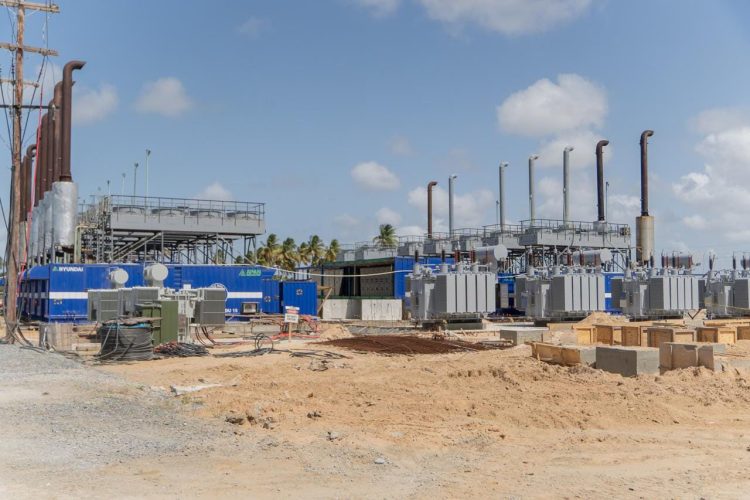GPL is unable to meet its current peak demand of 180 MW as generators have broken down and instead of sourcing new ones the government was preoccupied with the gas-to-energy project, according to APNU+AFC MP David Patterson.
The government has said that current generation is 178 MW and the peak demand is 180 MW meaning that there will be load shedding until second-hand generators from Honduras are producing optimally and a Turkish power ship arrives and is hooked up to the grid.
Patterson, former Minister of Public Infrastructure, in a recent interview with the Sunday Stabroek said that when he left office in 2020 generating capacity was 165 MW but they had procured 46.6MW generator sets that today should have seen the utility company with 211.6 MW with an adequate spinning reserve above peak demand.

“At 2020 we had 165 MW operational, and this was without the new 46.5MW generators that were procured and enroute, but delayed due to COVID. As of December 2023, they reported that GPL had 185 MW which includes the new 46.5 MW Wartsila gensets that were installed in Garden of Eden at the end of 2020,” Patterson told the Sunday Stabroek.
“You had functional gensets and then we bought new engines that were dual powered and could change over when gas came on stream. GPL prepared a plan that outlined what was there and what was needed. It’s no blame game but they ignored everything and focused solely on the Gas-to-Shore [project] and left the system to collapse,” he charged.
Patterson argued that regardless of what the Guyana Power and Light (GPL) says, the facts are there for the public to see and the truth needs no defence. That is because a 2020 analysis and study of the utility systems’ generating and transmission system was done by GPL and he advocates that it should be made public.
“It is all there. Everything I say, it is from information that was supplied by GPL. If they are saying that there were old generators when they took office, the thing to do is maintain them while you source new ones to replace it immediately. Not go and source secondhand that are not even running at capacity. Not wait until a crisis and source a power ship. We had all our sets working, old, new and the in between. Some sets now, when they are to give 20 MW are now only giving 3. How does that make sense?” he questioned.
Patterson also said he understands that “several of the generators broke down and had to be taken offline.”
In response to questions from this newspaper, GPL’s Management Commit-tee Head Kesh Nandall said that current installed generating capacity is 178 MW while current demand is 180 MW. Of the many generators at the plants across the coast and which serve the Demerara- Berbice Interconnected System, he said that two of the large generator sets at the Kingston Power Plant, totalling 13MW, were down for repairs, and at the Columbia Plant, two other gensets are not operational.
On April 18, Prime Minister Mark Phillips who has responsibility for the energy sector convened a meeting of stakeholders and GPL executives on the power supply situation.
According to a press release from his office, Nandlall provided an update on the generation situation.
Annual gross generation
He explained that the number of customers grew from around 140,000 in 2008 to over 227,000 currently, with a total annual gross generation increasing from 600 million megawatt-hours to 1.2 billion megawatt-hours and the peak demand growing from 73.5 megawatts to 186.4 for that period.
To meet the rising demand, according to Nandlall, GPL is making efforts to increase its generation capacity to address the current peak demand of 180 MW as of April 2024. He pointed out that in order to sustain system stability, the company has to maintain a spinning reserve of 14 MW, which requires an availability of 194 MW at the current peak demand.
He stated that currently, the Demerara-Berbice Interconnected System has an available capacity of 177 megawatts, including 20 megawatts from the Colum-bia Plant, which has a total capacity of 28.9 megawatts. Once fully operational, this plant will operate at 85% capacity by the end of April. GPL’s capacity will be further boosted with the arrival of a 36-megawatt net capacity power ship, which will come online at Everton, Berbice, in May. These additions will bring approximately 218 megawatts of firm generation capacity.
Additionally, the press release reported Nandlall as saying that it is expected that in May, a 6.9 MW generation unit will be added, and in July 2024, a 5.5 MW generation unit will come online at Kingston after maintenance, making an estimated total of 230.4 MW available to GPL.
Blazed
Nandlall has told the Sunday Stabroek that the power company is doing all it could with a dilapidated system it inherited, but Patterson has blazed government for what he termed “lack of foresight and strategic planning” as it relates to the frequency of power outages.
Earlier this month, he said that the state should desist from blaming the David Granger administration for a situation that was over 30 years old. Pointing out that that currently, there is a shortfall in generating capacity of approximately 35 to 40 MW, as several units are down at the Kingston location, while the new plants at Garden of Eden are operating below their listed capacity, he said it was caused by poor maintenance practices.
The former Minister contended that in 2015, the coalition government inherited a dysfunctional power system that was in dire need of major capital and technical investments. According to him, unlike the current government, his party did not seek to cast blame on its predecessors, but rather set about repairing and upgrading the entire power-generating network.
“Our priority was to determine the challenges facing the sector, then we proceeded to develop short, medium and long-term strategies to improve the network. This required hiring new management staff (an internationally recruited CEO), technical training for the existing staff, and procurement of additional generating capacity, upgrade and repairs to our poorly functioning transmission and distribution network. While we will readily admit that the sector was not perfect by 2020, it was, however, heading in the right direction,” he told the media.
“Despite the conflicting misinformation being peddled by the PPP, we procured over 60-plus megawatts of new generating power, upgraded over 1,000 kilometres of high and medium voltage lines, installed new transformers and boosted our protection network. These actions resulted in a more reliable electricity supply and a reduction in the frequency of blackouts. Notwithstanding the claims now being made by the PPP, the proof of the pie is in the eating. During no period under the coalition administration were blackouts so pronounced and frequent. This is an incontestable fact,” Patterson contended.
The media was apprised by the AFC member, of a comprehensive strategy to carry the sector forward, including that the gas-to-energy project was birthed under the coalition. “Albeit at quarter the cost of the current Wales gas-to-shore project. Funding was secured for several renewable projects, most of which have either been severely changed or abandoned by the PPP administration. Projects for major upgrades to the transmission and distribution network were underway, sadly these have also been shelved by the PPP.
“While the coalition administration considered a gas-to-shore project of 200 MW (US$500 million), as being the major generating source in the short to medium term, we also understood that until the commissioning of such a plant, additional investments in power generation would have been required during the interim period,” Patterson explained.
Request for Information
After the procurement of the 46.5MW plants now operating at Garden of Eden, GPL launched a Request for Information for an additional 50 MW. These bids were to be returned by September 1, 2020, however, the government scrapped this process, he added.
“Based on GPL’s expansion plans, 100 megawatts of new power was needed for the period 2020 to 2022. At the end of that period, the proposed gas-to-shore project, as originally designed, would have been commissioned, thus incrementally injecting a further 200 MW into the system. Sadly, all these plans were scrapped by the PPP, which has placed all their eggs in a single basket, being the Wales gas-to-shore project, a project which on its current trajectory will not deliver on its project promises,” he told the press.
“It is important to note that all the new generating sets proposed to be procured were designed as modular dual-fuelled units; in other words once natural gas was landed, these new sets in a matter of days, could have been switched over to natural gas, thus ensuring maximum value for our investment. The new Garden of Eden plants already have this capability. The PPP version was to mothball all our existing plants, thus making all earlier investments ‘sunk costs’.
“GPL has more than 20 maintenance overhauls scheduled for 2024, some of which were deferred from last year. Unfortunately, due to the shortage of generating capacity, these maintenance programmes will have to be deferred since taking any of the generating sets offline will further increase the energy deficit. This was the same position that the coalition inherited in 2015, which was corrected but has now resurfaced with the return of the PPP. No amount of PR, untruths and misinformation will resolve our electricity woes, nor will it replace equipment destroyed by continuous voltage fluctuations. Families and businesses need the government to make improvements within a properly constructed plan and provide a stable, reliable service for customers, which is foundational to our country’s development”, Patterson asserted.
In an exchange with the media on April 16, President Irfaan Ali cited additional demand for energy and defended the deal for the power ship but did not refer to the fact that generators were out of order.
“You want blackouts? This is the problem with the media. You love writing headlines…that ‘Blackout!’ [and] oh, power outages!…’ The media has responsibilities too, my dear. We said to you that there are a number of problems. One of them is capacity. The exponential growth and the lack of capacity. How do you get capacity? You have to buy capacity. You can’t wish that capacity will come and that the problem will be solved. You have to buy capacity. The question you should ask is, should we not charge the persons that blocked the Amaila Falls? Otherwise we would not need to buy this capacity” Ali contended.
It was only in September last year that GPL announced that it was procuring 17 generators from Honduras with output of 28.9 mw to cope with the extra Christmas demand. They were supposed to have been installed by December 15th last year. Up to earlier this month all of them had not yet been installed and were also producing below capacity. With that still not being enough, the government earlier this month announced plans for 36 MW from a Turkish power ship which is now on its way from Cuba.
Even when generation is above peak demand, GPL will also have to deal with ongoing transmission and distribution problems which lead to frequent trips in the system and power cuts.









